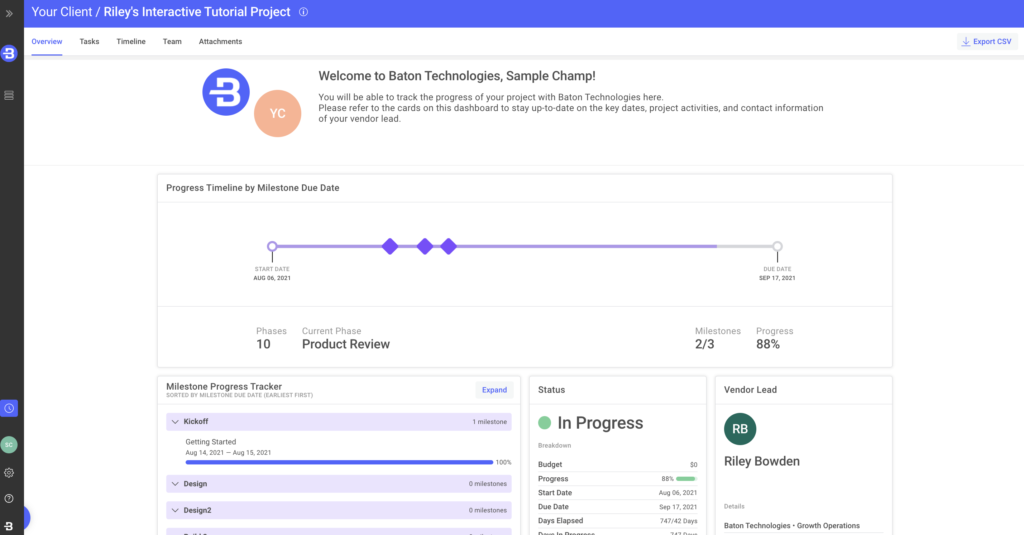In this blog we explain how SaaS vendors can leverage a client portal to increase visibility and accountability during implementation.
What is a client portal?
A client portal is a centralized place your customers go to get real-time information as it relates to the status of a project. It creates a seamless experience for both the vendor and the client. Portals replace static project plans and updates via email with a living and breathing project plan, real-time visibility, and automated communication.
A client portal serves as your pre-point-of-contact. Project plans, relevant documents, client-assigned tasks, and audit trails live here.
Why is it important?
Saas implementations are collaborative by nature. If your process doesn’t feel like a collaboration, the relationship probably isn’t off to the best start.
Buy-in from both the vendor and the client is key to a successful implementation. What creates buy-in? Obviously it starts with your product filling a real need for your customer. Beyond that, it comes down to execution.
What we see from the best software vendors is a clear and concise go-live plan that is shared with the entire project team–which includes the customer. These companies take an iterative approach to process improvements, they track everything, and above all they share a roadmap with their customers on what success looks like.
That last point is the key. Even if you have a perfect project plan, it will be impossible to execute if everyone is in the dark on phases, milestones, and tasks associated. A poor onboarding experience is one of the top 3 reasons customers churn. Poorly communicated success plans contribute to a poor onboarding experience.
Visibility and Accountability During Client Implementation
We’ve talked with thousands of SaaS vendors about their onboarding and implementation processes. One of the biggest pain points in complex and lengthy implementations is customer engagement. That may take the form of collecting relevant documents, setting up integrations, or just simple administrative tasks. This is how a few vendors have put it.
“Well that isn’t necessarily easy to obtain from the customer.”
“We have some customers who are constantly requesting status updates.”
“Getting them to do that is a lot like pulling teeth.”
The good news is, there is software that exists that can turn client engagement from something that invokes thoughts of the dentist’s office to something that feels like a breeze.

Increasing visibility and accountability are the two main benefits of sharing and agreeing upon a project plan with customers. A living client portal is a catalyst for visibility and accountability. Controlling the controllables is paramount for implementation and customer success managers, and proactive communication is controllable.
A centralized client portal first increases project visibility for your client. Done right, your customer can actually visualize a path to a successful implementation. There is probably a scientific study to reference here, but we will just stick with common sense: seeing a real path to success is a good thing.
You, as a vendor, also benefit from this. If your customer is able to go to a single source to see project status, task assignment, etc., it will reduce the amount of time you spend preparing status updates and sending emails. We’ve said it before, but automating project administration is the easiest way to free yourself up to focus on high-impact activities that deliver for your customer.
Accountability is a byproduct of visibility. If implementation is a collaborative exercise, accountability is a two-way street. You need your customer to complete certain tasks to get them live.
If client assigned tasks are clearly laid out in your project plan, it is clear where the accountability lies. Ultimately you are responsible for customer support, but sharing expectations and tasks at kickoff can help mitigate any confusion when task due dates are coming up.
How Your Tools Should Help
With a tool like Baton, you can assign clients tasks and automate reminders. You can also add crisp task descriptions to lay out how tasks can be completed. To take this a step further, your clients can update task status in Baton without even leaving their email inbox.
A client portal can help you and your team aggregate real-time feedback from clients during the implementation process. In Baton, check-in surveys can be scheduled and automated after phases, milestones, and projects are completed. This can provide you with actionable insights on how you can improve your implementation process from your customer’s point of view.
Increased client engagement has a material impact on project speed and success. We published a case study with Loadstop to show how this works in practice.



